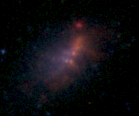
Messier 83 or M83, also known as the Southern Pinwheel Galaxy and NGC 5236, is a barred spiral galaxy approximately 15 million light-years away in the constellation borders of Hydra and Centaurus. Nicolas-Louis de Lacaille discovered M83 on 23 February 1752 at the Cape of Good Hope. Charles Messier added it to his catalogue of nebulous objects in March 1781.
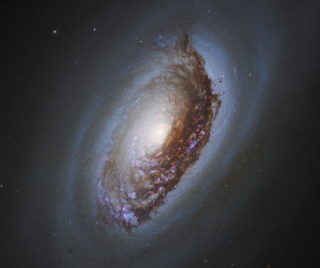
The Black Eye Galaxy is a relatively isolated spiral galaxy 17 million light-years away in the mildly northern constellation of Coma Berenices. It was discovered by Edward Pigott in March 1779, and independently by Johann Elert Bode in April of the same year, as well as by Charles Messier the next year. A dark band of absorbing dust partially in front of its bright nucleus gave rise to its nicknames of the "Black Eye", "Evil Eye", or "Sleeping Beauty" galaxy. M64 is well known among amateur astronomers due to its form in small telescopes and visibility across inhabited latitudes.

NGC 404 is a field galaxy located about 10 million light years away in the constellation Andromeda. It was discovered by William Herschel in 1784, and is visible through small telescopes. NGC 404 lies just beyond the Local Group and does not appear gravitationally bound to it. It is located within 7 arc-minutes of second magnitude star Mirach, making it a difficult target to observe or photograph and granting it the nickname "Mirach's Ghost".
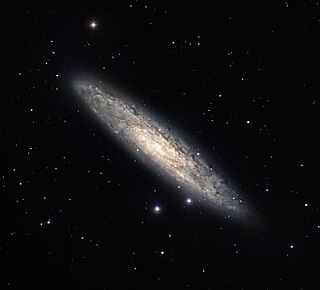
The Sculptor Galaxy is an intermediate spiral galaxy in the constellation Sculptor. The Sculptor Galaxy is a starburst galaxy, which means that it is currently undergoing a period of intense star formation.
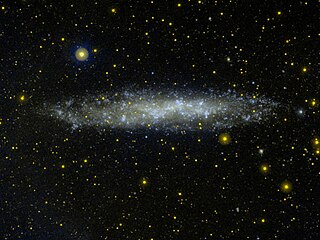
NGC 3109 is a small barred Magellanic type spiral or irregular galaxy around 4.34 Mly away in the direction of the constellation of Hydra. NGC 3109 is believed to be tidally interacting with the dwarf elliptical galaxy Antlia Dwarf. It was discovered by John Herschel on March 24, 1835 while he was in what is now South Africa.

NGC 1569 is a dwarf irregular galaxy in Camelopardalis. The galaxy is relatively nearby and consequently, the Hubble Space Telescope can easily resolve the stars within the galaxy. The distance to the galaxy was previously believed to be only 2.4 Mpc. However, in 2008 scientists studying images from Hubble calculated the galaxy's distance at nearly 11 million light-years away, about 4 million light-years farther than previous thought, meaning it is a member of the IC 342 group of galaxies.

NGC 2683 is a field spiral galaxy in the northern constellation of Lynx. It was nicknamed the "UFO Galaxy" by the Astronaut Memorial Planetarium and Observatory. It was discovered by the astronomer William Herschel on February 5, 1788.

NGC 2976 is a peculiar dwarf galaxy in the northern circumpolar constellation of Ursa Major. It was discovered by German-born astronomer William Herschel on November 8, 1801, and catalogued as H I.285. J. L. E. Dreyer described it as, "bright, very large, much extended 152°, star involved". It is a member of the M81 Group and lies 1° 20′ to the southwest of Messier 81. The projected separation of this galaxy from the M81 Group is 190 kpc.
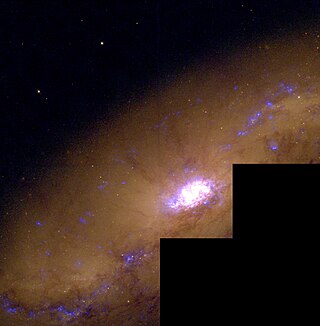
NGC 1808 is a barred spiral galaxy located in the southern constellation of Columba, about two degrees to the south and east of Gamma Caeli. It was discovered by Scottish astronomer James Dunlop, who described it as a "faint nebula". The galaxy is a member of the NGC 1808 group, which is part of the larger Dorado Group.
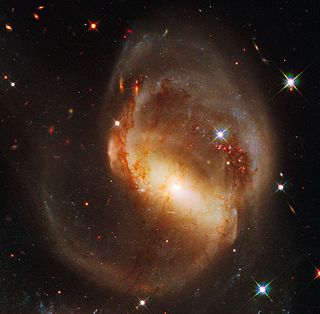
NGC 7319 is a highly distorted barred spiral galaxy that is a member of the compact Stephan's Quintet group located in the constellation Pegasus, some 311 megalight-years distant from the Milky Way. The galaxy's arms, dust and gas have been highly disturbed as a result of the interaction with the other members of the Quintet. Nearly all of the neutral hydrogen has been stripped from this galaxy, most likely as a result of a collision with NGC 7320c some 100 million years ago. A pair of long, parallel tidal tails extend southward from NGC 7319 in the direction of NGC 7320c, and is undergoing star formation.

NGC 4138 is the New General Catalogue identifier for a lenticular galaxy in the northern constellation of Canes Venatici. Located around 52 million light years from Earth, it spans some 2.1 × 1.3 arc minutes and has an apparent visual magnitude of 11.3. The morphological classification of NGC 4138 is SA0+(r), indicating it lacks a bar formation and has tightly wound spiral arms with a ring-like structure around the nucleus. It has no nearby companion galaxies.

NGC 1792 is a spiral galaxy located in the southern Columba constellation. It was discovered by Scottish astronomer James Dunlop on October 4, 1826. This galaxy is located at a distance of about 36.4 million light-years and is receding from the Milky Way with a heliocentric radial velocity of 1,208 km/s. NGC 1792 is a member of the NGC 1808 cluster of galaxies.
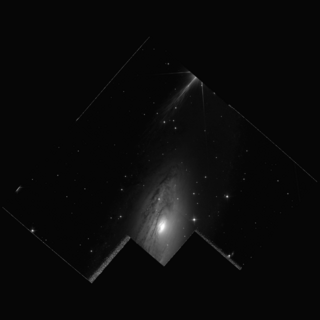
NGC 7013 is a relatively nearby spiral or lenticular galaxy estimated to be around 37 to 41.4 million light-years away from Earth in the constellation of Cygnus. NGC 7013 was discovered by English astronomer William Herschel on July 17, 1784 and was also observed by his son, astronomer John Herschel on September 15, 1828.

NGC 4522 is an edge-on spiral galaxy located about 60 million light-years away within the Virgo Cluster in the constellation Virgo. NGC 4522 is losing its molecular gas though ram-pressure stripping as it plows though the cluster at a speed of more than 10 million kilometres per hour. The galaxy was discovered by astronomer John Herschel on January 18, 1828.
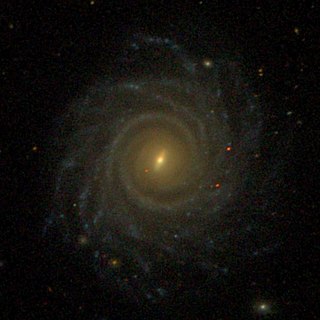
NGC 3883 is a large low surface brightness spiral galaxy located about 330 million light-years away in the constellation Leo. NGC 3883 has a prominent bulge but does not host an AGN. The galaxy also has flocculent spiral arms in its disk. It was discovered by astronomer William Herschel on April 13, 1785 and is a member of the Leo Cluster.

NGC 4299 is a featureless spiral galaxy located about 55 million light-years away in the constellation Virgo. It was discovered by astronomer William Herschel on March 15, 1784 and is a member of the Virgo Cluster.

NGC 1142 is a distorted spiral galaxy in the constellation of Cetus. It is located about 370 million light years away from Earth, which means, given its apparent dimensions, that NGC 1142 is approximately 170,000 light years across. It is a type 2 Seyfert galaxy. It interacts with the elliptical galaxy NGC 1141.

NGC 3175 is a spiral galaxy located in the far eastern part of the southern constellation of Antlia at an approximate distance of 54 million light-years. NGC 3175 was discovered on March 30, 1835 by English astronomer John Herschel, whose notes described it as, "considerably bright, large, much extended NE-SW, very gradually little brighter middle". This galaxy is the namesake of the NGC 3175 group of galaxies, which includes the spiral galaxy NGC 3137.

NGC 4324 is a lenticular galaxy located about 85 million light-years away in the constellation Virgo. It was discovered by astronomer Heinrich d'Arrest on March 4, 1862. NGC 4324 has a stellar mass of 5.62 × 1010M☉, and a baryonic mass of 5.88 × 1010M☉. The galaxy's total mass is around 5.25 × 1011M☉. NGC 4324 is notable for having a ring of star formation surrounding its nucleus. It was considered a member of the Virgo II Groups until 1999, when its distance was recalculated and it was placed in the Virgo W Group.
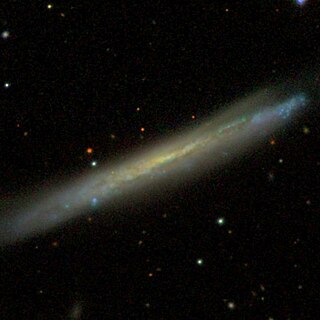
NGC 3044 is a barred spiral galaxy in the equatorial constellation of Sextans. It was discovered on December 13, 1784, by German-born English astronomer William Herschel. In 1888, Danish astronomer J. L. E. Dreyer described it as "very faint, very large, very much extended 122°". It is located at an estimated distance of 67 million light years. In the B band of the UBV photometric system, the galaxy spans 4.70′ by 0.80′ with the major axis aligned along a position angle of 113°. It is a relatively isolated galaxy with no nearby companions. R. B. Tully in 1988 assigned it as a member of the widely displaced Leo Cloud.
